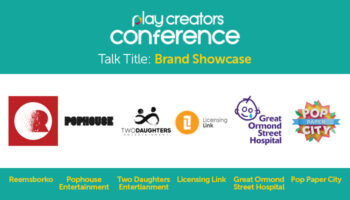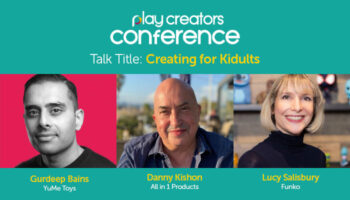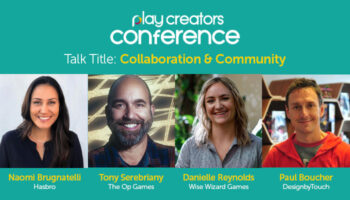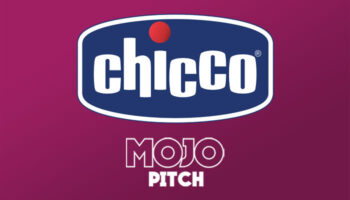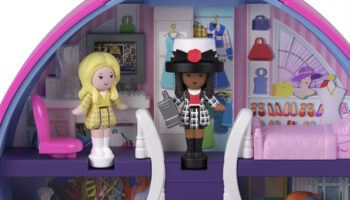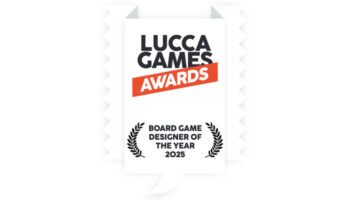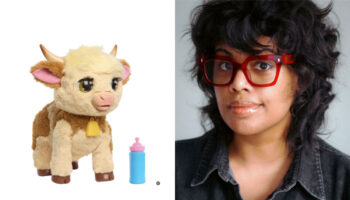Is no news good news?! Rich Mazel and Dougal Grimes team up to discuss inventor relations at Spin Master

Dougal and Rich in a joint interview: feels like a bit of a coup… If I was in America, would this be possible in real life? By which I mean: how often are the two of you actually in the same room together?
Rich: Dougal and I have just started back travelling on the road together so it’s starting to happen again… But with Covid and a gap between when we joined Spin Master, it was a few years.
Dougal: Of course, the past few years have been crazy, but recently Rich and I got to go on our first Inventor Sweep together in three years. It kind of felt like yesterday we were doing it, and it’s just as fun as ever.
It’s good to be back, then?
Rich: It’s so much fun, and also more productive – there’s only so much collaboration that can be done on video conferences. We’ll be coming to London for Distoy and we’re both super happy to see everyone and go to our favourite spots. First up for me is a nice big pancake at the Old Dutch in Kensington, and a walk through Hyde Park – my favourite park in the world.

Is there a downside to the two of you travelling together?
Rich: There was once a rumour that we couldn’t ride on the same airplane, or eat at the same restaurants, due to the potential impact to the industry if something was to happen…
Dougal: To be honest, it was less a rumour and more just something that Rich thought “would sound cool”. He suggested it to me on a Southwest Airlines flight from Lubbock, Texas to Wichita, Kansas. We were eating free pretzels and excitedly watching the movie Air Force One on the seatback monitor – headphone volume set to 10.
Air Force One! So we’ve talked before about how you chaps think and work. I’m keen to hear, though, what happens to ideas AFTER inventors pitch them to you… So first, what happens to ideas you don’t like straight away? Do you ever say no in a meeting?
Rich: We’ll say no in the meetings if we see an obvious flaw or cost, or conflict with previous work, a bad fit and so on… But we’ll also ask for items to come into our portal for a second look prior to showing the brand team. There are multiple levels where we cull the list to try to put together the best ‘playlist’ of concepts for the various brand teams. We see a lot of items, and have lots of internal meetings, so we try to give timely and meaningful feedback. There’s a lot of activity going on behind the scenes as we work with the brands to develop cool stuff!
And how do you say no in the room so that it isn’t crushingly disappointing?
Dougal: It’s always going to be disappointing for an inventor to hear a no, but the more seasoned inventors are well accustomed to hearing that word… And most even welcome a ‘Fast No’ so they can just get to other concepts that might be of interest.

That’s a fair point, actually…
Dougal: To avoid any crushing disappointment, we do explain our reasons for the no. Perhaps it’s not a right fit for our company, maybe we already have something in the line or under development that’s similar… Maybe we’re using our own development knowledge to give feedback as to why the concept may not work in the market. If that’s the case, we usually try and offer up suggestions on how to improve the concept. We’ll try to ensure that we relay where the company’s needs are, and – with our experience – where inventors should focus.
And to what degree do you offer that feedback? Do you have a particular format that you think is helpful?
Rich: The biggest thing is gut feel and combining that with knowledge of the industry, and the needs of the brand team at that time. We typically give feedback to the inventor if we think we have something to add. Also, we’re kids at heart, so we can also go off track with just having fun in the meetings.
That has been noted! And on the back of that, have you ever had the experience of an inventor – seeing that a no is coming – say something that then turns it all around?
Rich: Yes, it happens for sure. Sometimes we see a new twist or new application as we keep talking. It’s a delicate balance as I don’t think it’s useful to oversell the concept, but a collaborative chat can lead to good things. On the opposite side, if you’re a new inventor and we say yes, I find it best to “take the win” and move onto the next item. It’s an old piece of comedy showmanship – end on a high note with us wanting more!

An unexpected answer; interesting. Dougal; same question…
Dougal: Yes, sometimes an inventor’s model or presentation may have let them down in some way, and they have additional thoughts on the benefits or features of the concept that need sharing… They can totally turn it around. And as Rich says, the collaborative chat can sometimes unearth new thinking or opportunities that weren’t apparent at first, so the best inventors always go into pitch meetings with an open mind… They aren’t as precious about the item they’re showing – they’ll pivot as to what it can be.
You know, I had that exact experience recently myself… I finished explaining an idea. The publisher misunderstood one bit of it – but loved it. They more or less sold themselves on the misunderstanding. I should argue?! It ended up being a better idea!
Rich: Right!
So now, I realise you probably can’t go into detail, but – broadly speaking –what happens to ideas you like after the pitch? What’s the process at Spin Master?
Rich: We’ll ask the inventor to submit the concept and associated assets – videos, presentations, PDF’s, photos and so on – to our secure online portal. We’ll then review the new submissions weekly, and decide which move forward to show the brand teams.
So you effectively put it to the brand teams on the inventor’s behalf?
Rich: Yes! And from there, the concept could be taken in by the brand team for further consideration, or rejected for a variety of reasons. The goal of the
inventors, and my team, is to find something that the brand teams move forward with and becomes a toy or game on shelf!

Dougal: The internal teams may spend weeks or months looking to create a product from an item. It’s in this time we may offer options to inventors to allow us the time to review. Spin Master always brings in the inventors during this time, especially if they have specific skills such as CAD, programming, game development, copywriting and so on. The internal teams are usually curating their development pipeline to present at a larger internal meeting, usually called a line review.
I think that’s important to clarify: after inventors pitch to you, and you’ve pitched it to other people, still more people have to see it and review it?
Rich: Right. And once the inventor concept is seriously considered by the teams internally, there’s still a lot of work to be done… Showing us is the first step in a long journey to get to shelf.
It’s a long way to market… Let me ask you this: with some companies, optioning an idea seems to be a very hit-and-miss affair… Why might that be, do you suppose?
Rich: I think that’s more a result of a lot of ideas and a limited amount of shelf space. A lot of ideas we see are super clever, but there are only so many toys that retailers can put on shelf…
Dougal: It’s interesting – Rich lives in LA and has spoken to people who read and pick scripts for movies… We were both surprised at how similar the process is – and how similar the odds are!

And does Spin Master offer options to new inventors? Or continue to offer them to established inventors?
Dougal: New inventors have the same shot at options and licenses. Now, that being said, professional inventors know the business very well and have committed a lot of time and resources to the industry… But it you have a truly great idea, innovation always trumps other factors.
Innovation always trumps other factors… Intriguing. Alright! I’ve never entirely agreed with the saying “No news is good news…” There’s no news on Glenn Miller, for example, or Jimmy Hoffa…
Dougal: Ha! That’s funny!
Am I wrong? No news on Amelia Earhart. No news on Shergar! That’s not good! Here’s the question… Given how busy inventor-relations people are, how long should inventors wait – with no news – before following up with you?
Dougal: It really depends on each item as they have their own rhythm. It also depends on the concept, the brand, the time of year. The general rule of thumb is to try to wait 60 days for it to get to the system – and hopefully be surprised when and if we can get back faster.
And how should they follow up with you? What’s the best way to put air in the sails without rocking the boat?
Rich: I would “get on board” with the process, and prepare to “batten down the hatches” without “making waves”… Sorry, got caught up in nautical phrases there.
Ha! Nautical – but nice!
Rich: It’s actually pretty simple. Maybe say, “Hey, how’s it going on item X? Any update?”

Friendly. Concise. Direct!
Rich: As soon as we get new information, we’re happy to share that. But in most cases – and to use your words – “No news is neither bad nor good.” It really depends on the factors we’ve discussed.
We’re dangerously close to a Shakespeare quote: “There is nothing either good or bad, but thinking makes it so.” Alright! Chaps, I’ve already kept you for quite awhile; perhaps we should start wrapping this up. Broadly speaking, though, what other advice would you give inventors about following up?
Rich: I’d say that we really care about inventors and inventor concepts. We want to give as timely and as meaningful feedback as possible. Our only goal is mutual success. It reminds me of sports umpires…
Umpires?
Dougal: Rich was a baseball umpire for youth when he grew up!
Okay!
Rich: So umpires can get a lot of “help from the stands”, but are typically there because they love the game – and we certainly love the toy game.

Dougal: I’d also say, “trust the process”. As a company gets larger, it becomes more complex with its processes and timings. So a little bit of patience and understanding goes a long way. This can be a good thing also, as a company’s growth usually means it can get your product out to a bigger global audience!
And on that point, then, to what degree is inventor feedback a two-way street? How helpful is it for you to get feedback from inventors on how THEY felt a pitch went?!
Rich: That’s interesting… We’ve sent out questionnaires and are always looking to improve the experience for people pitching to us. The inventors have taken the time and effort to show us their idea, and we love that and want Spin Master to be the best place for inventors to bring their ideas. I’d say we’ve made significant changes over the years due to feedback from the inventor community. We also love talking to the legends of toys and games, and we ask for – and are grateful for – all their advice along the way on how to be better at what we do.
Interesting!
Dougal: Both Rich and I have a very ‘friendly’ style to our jobs, and we tend to get to know inventors – which is great when you’re on the road or at events. It can feel like you’re a global family – and because of this we generally enter into conversations with inventors at ‘after work’ events that might be less intimidating or formal than a pitch. It’s usually there that we get the REAL feedback.
I’ll bet! Fantastic. Alright, gents… Final question: what question could I have asked each of you today that you would have loved to answer? And what IS the answer?
Rich: I wished you asked, “Hey, Her Royal Majesty would like you to come over and figure out how to put a go-kart track in Buckingham Palace and liven the place up a bit. Unlimited budget and creative control, are you in?”. The answer is a resounding “YES”.

But I turned down a call from her to speak to you! Dougal?
Dougal: “Is there a formula for a successful toy or game?” The answer is “NO! And beware anyone that claims there is!” Part of this whole wonderful industry is the fact you have to try different things, experiment, reinvent and reimagine play and it’s not going to work the whole time. The best approach is to keep learning from mistakes and failures, and stay open to new trends and new consumers!
Lovely! Thank you both so much for making time; lovely to see you and hear your thoughts.
–
To stay in the loop with the latest news, interviews and features from the world of toy and game design, sign up to our weekly newsletter here



